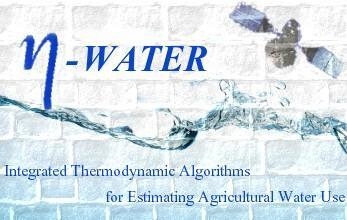Integrated Methodology for Estimating Water Use in Mediterranean Agricultural Areas
Abstract
:1. Introduction
2. Materials and Methods
2.1. Description of Study Area
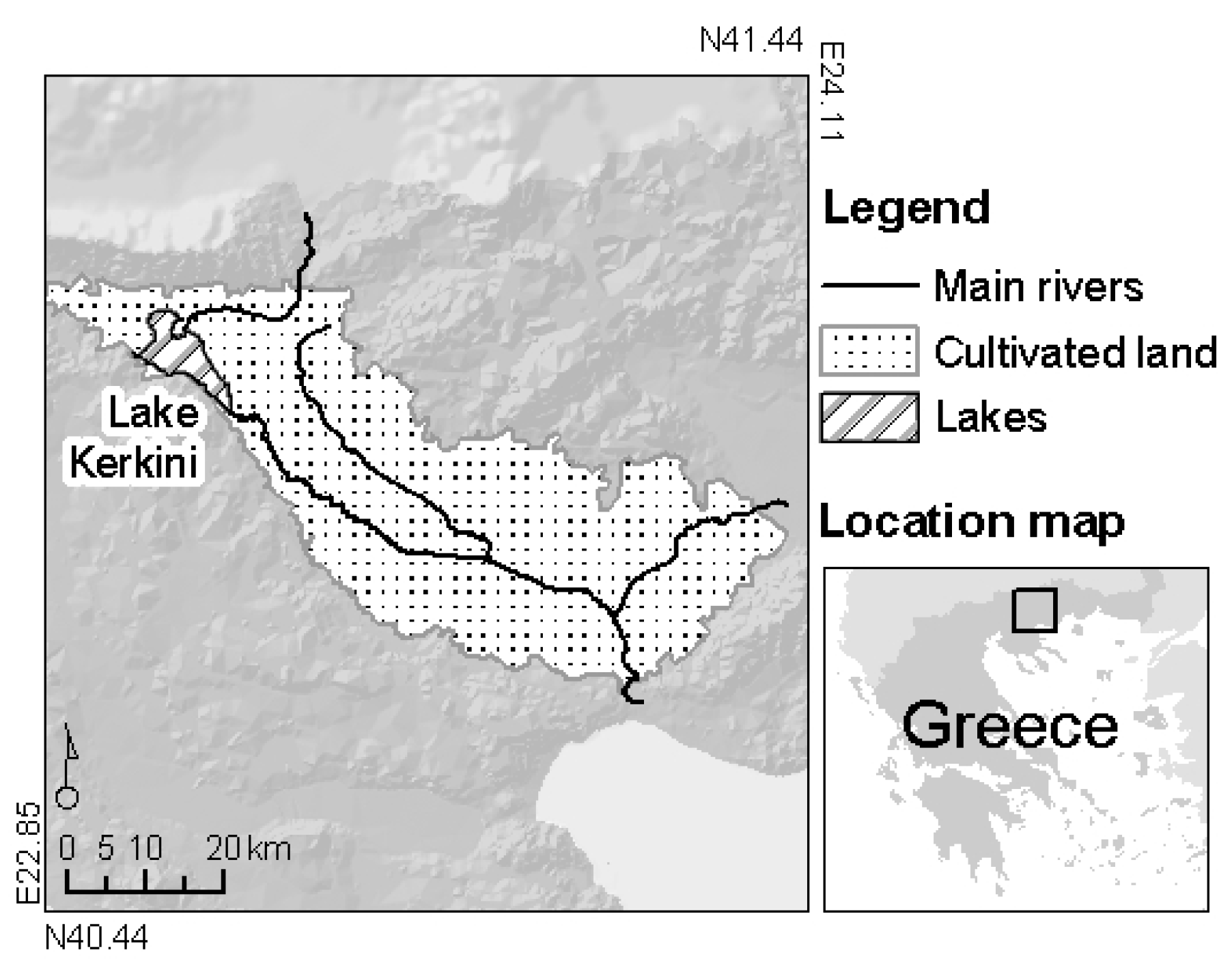
2.2. Data Description
2.3. Integrated Methodology Customized for Greek Conditions
2.3.1. Estimating surface energy fluxes


2.3.2. Customization of Albedo (α) estimation

2.3.3. Customization of air temperature (Ta) estimation



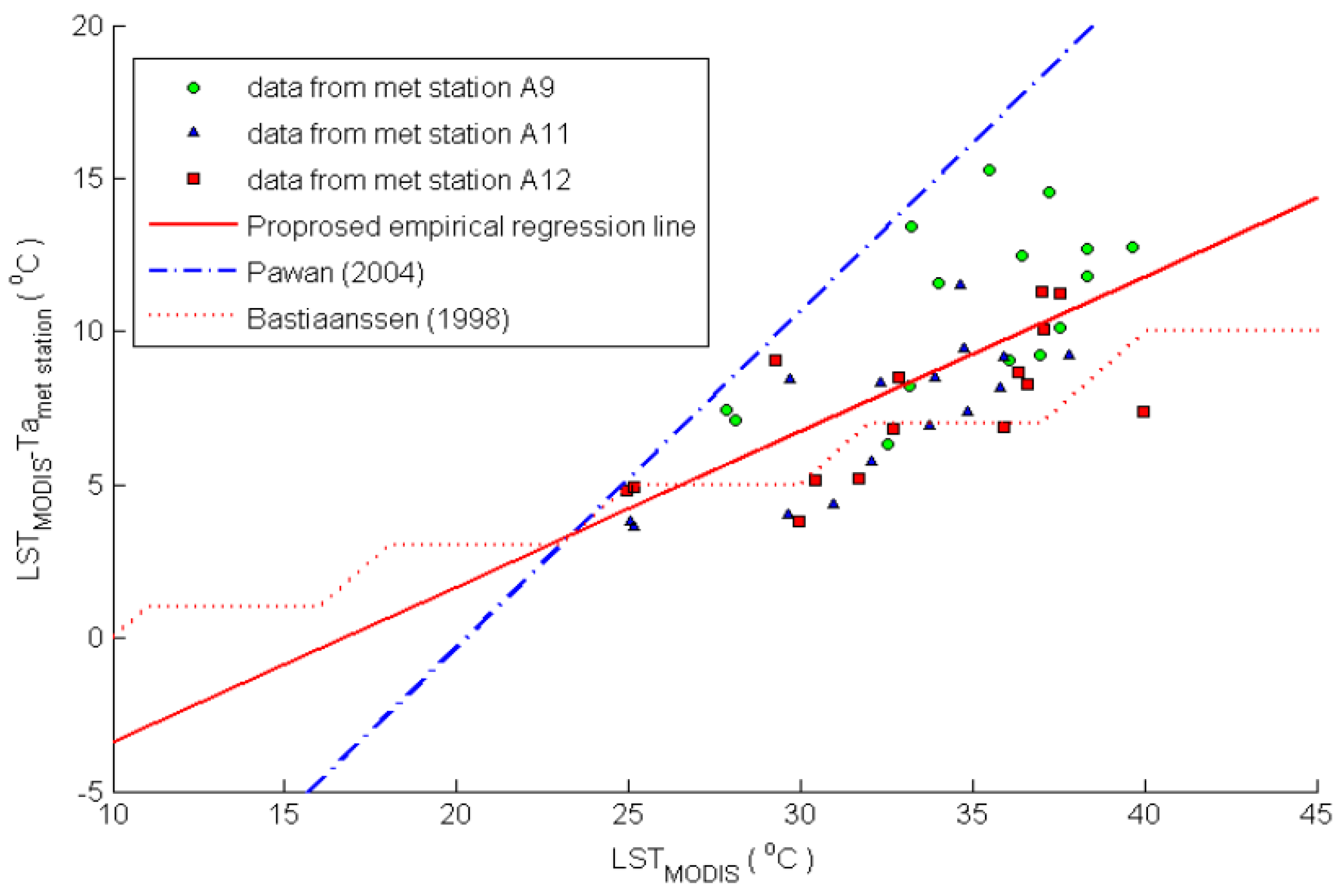
2.3.4. Considerations in extreme pixel selection
2.3.5. Integrating over the temporal dimension

2.3.6. Improving spatial resolution

 is the average of the values of ETETM+ (Landsat) that occupy a pixel of ETs (NOAA). Using this proportional distribution method, the total ETs value calculated for each area of 1.21 km2 was preserved, but redistributed according to the detailed pattern of ETa derived from the ETM+ image. The advantage of the method is that it minimizes the influence of the high-resolution image induced in the methods found in literature (IHS and PC transformation).
is the average of the values of ETETM+ (Landsat) that occupy a pixel of ETs (NOAA). Using this proportional distribution method, the total ETs value calculated for each area of 1.21 km2 was preserved, but redistributed according to the detailed pattern of ETa derived from the ETM+ image. The advantage of the method is that it minimizes the influence of the high-resolution image induced in the methods found in literature (IHS and PC transformation). 2.4. Development of the ITA-Water Tool
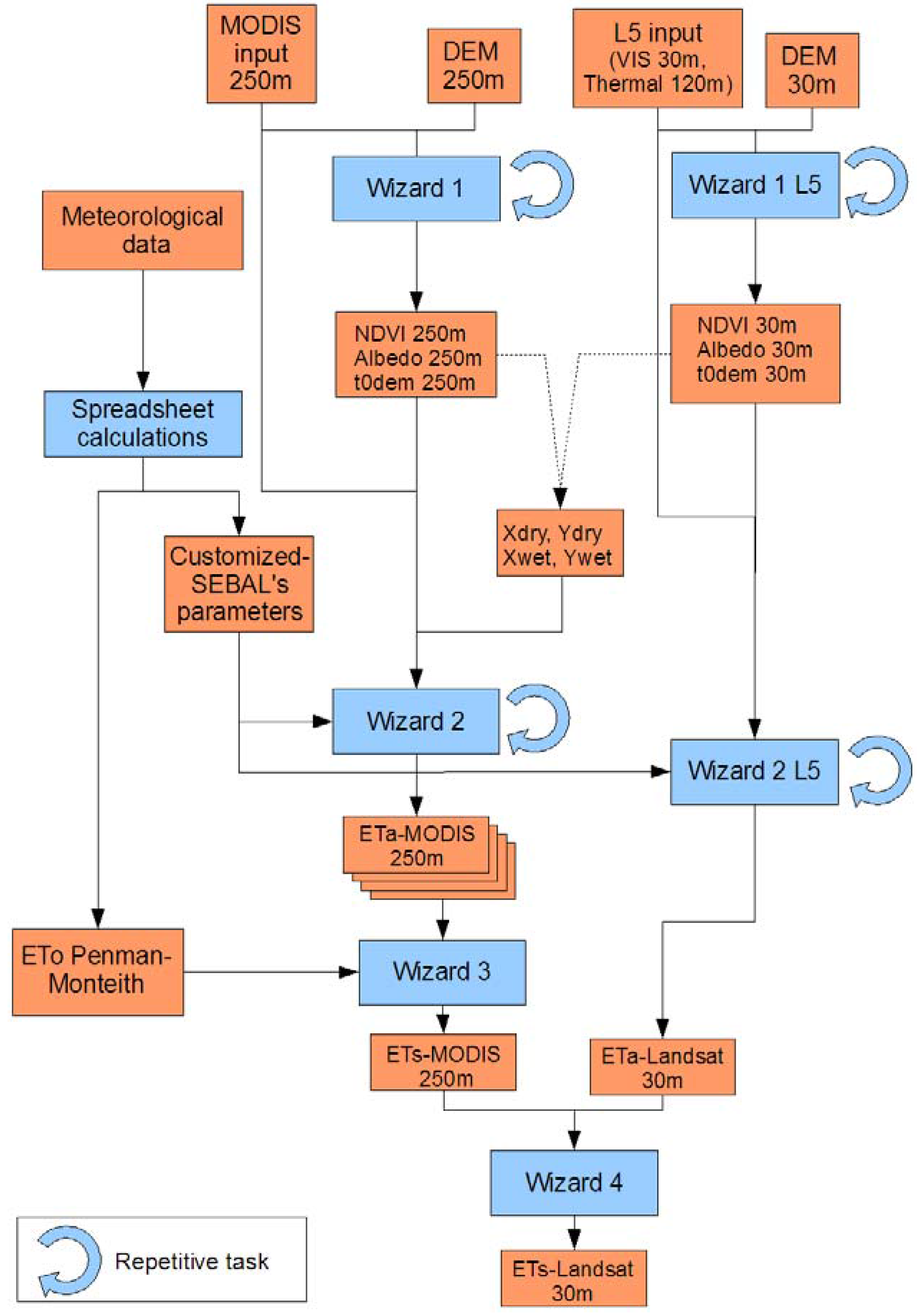
3. Results and Discussion
3.1. Experimental Results in Strimonas River Basin
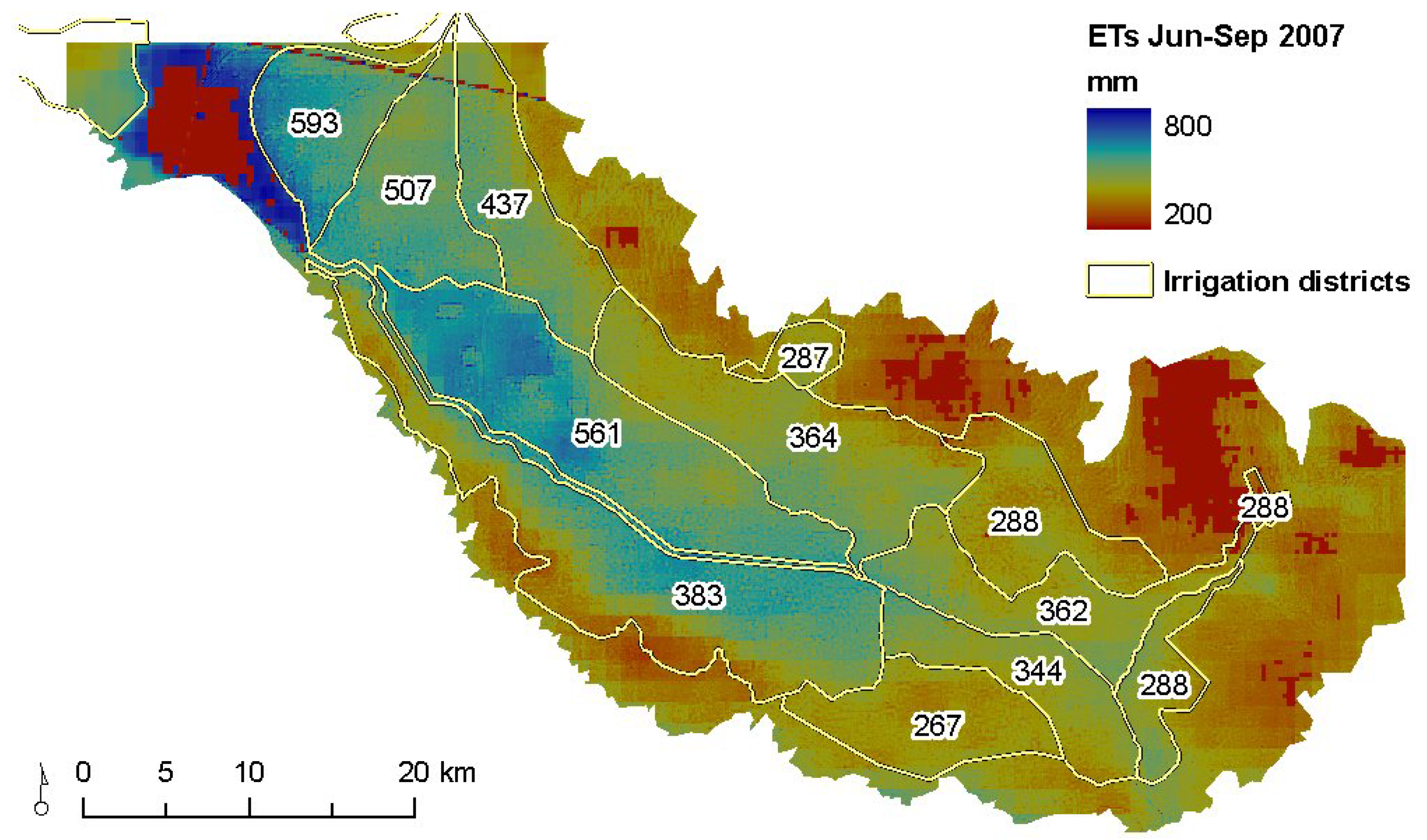
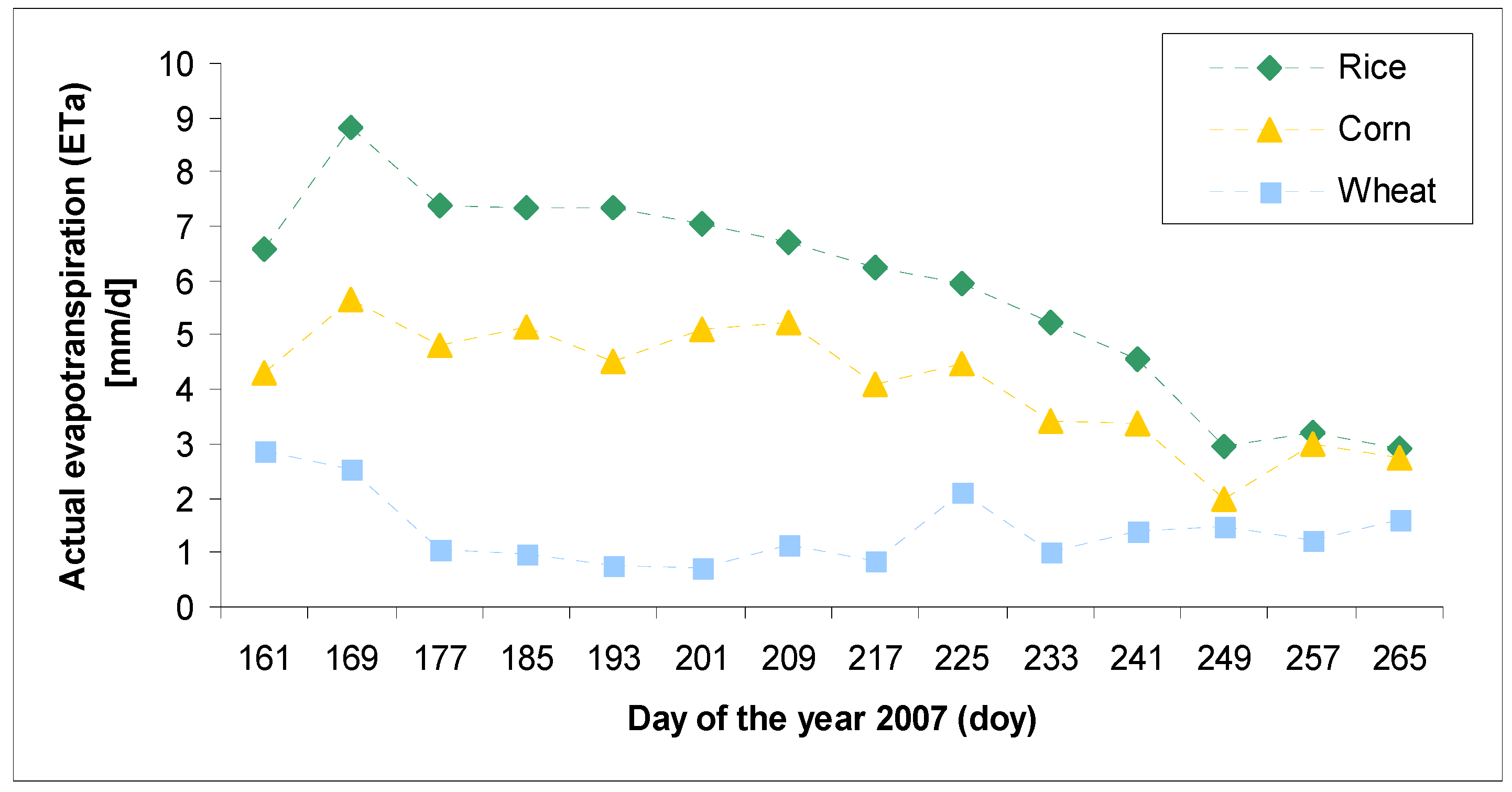
3.2. Elements of Validation
3.2.1. Quality assessment breakpoints
3.2.2. Validation of ETa-MODIS maps using ETc meteorological data
3.2.3. Validation of ETs-Landsat map using reference water supply data
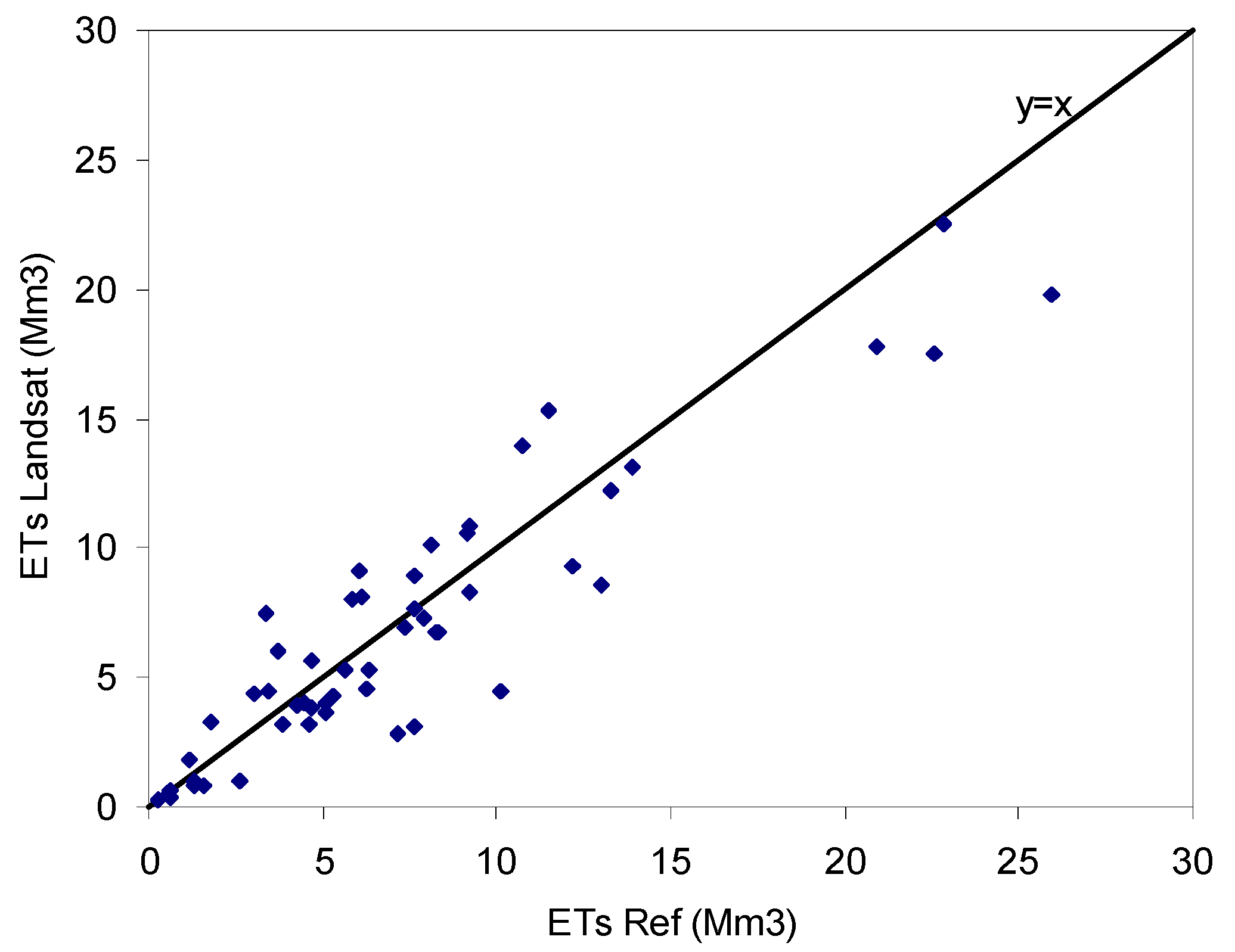
3.2.4. Validation of the spatial resolution improvement method
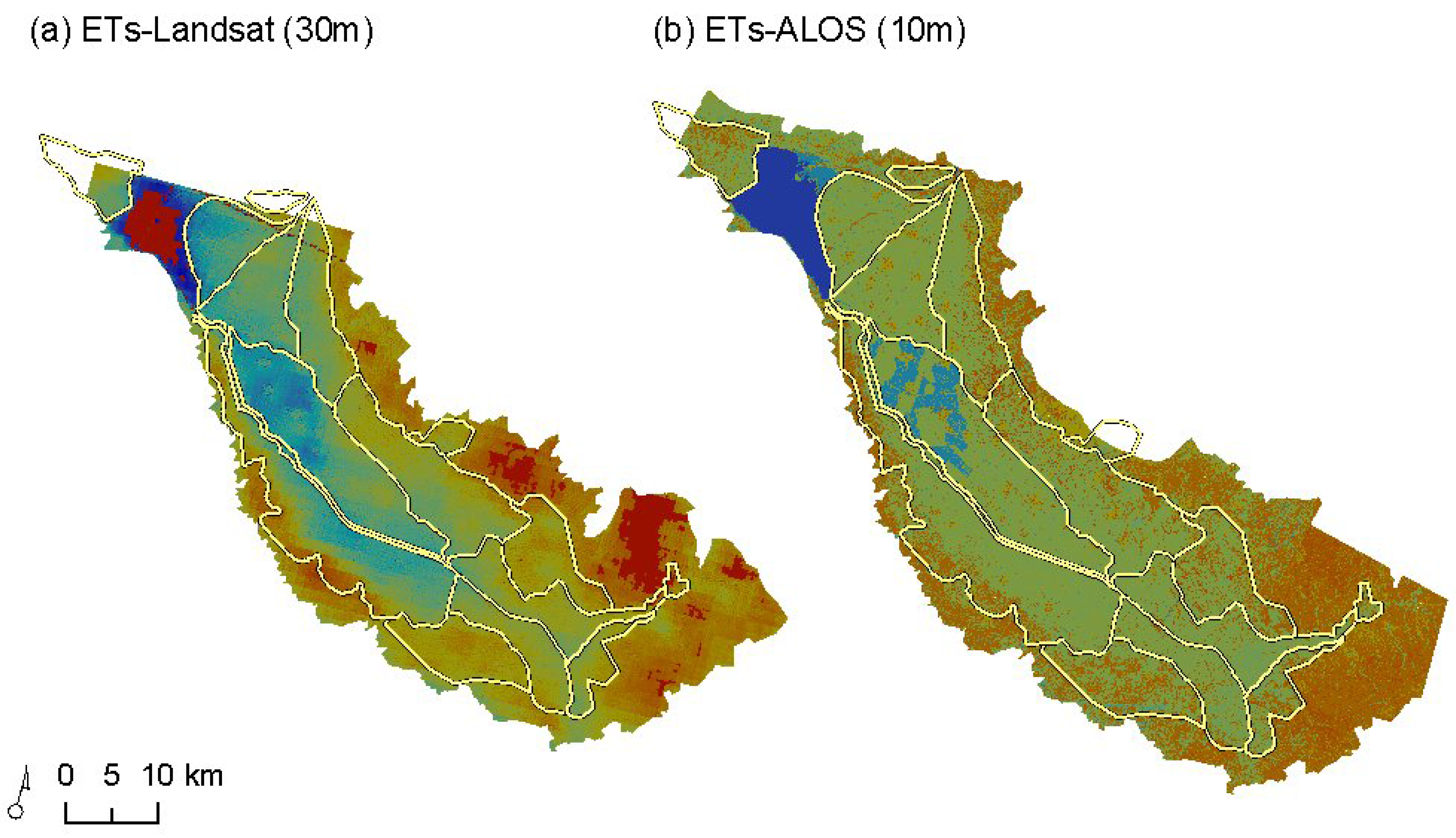
3.3. Discussion
3.3.1. Advantages of the methodology
3.3.2. Regionalization and implications for water management
4. Conclusions
Acknowledgments
References and Notes
- Seckler, D.; Barker, R.; Amarasinghe, U. Water scarcity in the twenty-first century. Int. J. Water Resour. 1999, 15, 29–42. [Google Scholar] [CrossRef]
- Shiklomanov, I.A. Appraisal and assessment of world water resources. Water Int. 2000, 25, 11–32. [Google Scholar] [CrossRef]
- FAO; IFAD. Water for food, agriculture and rural livelihoods. In: The United Nations world water development report 2: Water, a shared responsibility; UNESCO and Berghahn Books: Paris and New York, 2006; Available online: http://unesdoc.unesco.org/images/0014/001454/145405E.pdf (accessed on November 27, 2007).
- EC Directive 2000/60/EC of the European Parliament and of the Council of 23 October 2000 establishing a framework for Community action in the field of water policy. Off. J. Europ. Union 2000, 1–73.
- Lianos, T.P.; Parliarou, D. Farm size structure in Greek agriculture. Eur. Rev. Agric. Econ. 1986, 13, 233–248. [Google Scholar] [CrossRef]
- Meijninger, W.M.L.; De Bruin, H.A.R. The sensible heat fluxes over irrigated areas in western Turkey determined with a large aperture scintillometer. J. Hydrol. 2000, 229, 42–49. [Google Scholar] [CrossRef]
- Su, H.; McCabe, M.F.; Wood, E.F.; Su, Z.; Prueger, J.H. Modeling evapotranspiration during SMACEX: Comparing two approaches for local- and regional-scale prediction. J. Hydrometeor. 2005, 6, 910–922. [Google Scholar] [CrossRef]
- van Dam, J.C.; Huygen, J.; Wesseling, J.G.; Feddes, R.A.; Kabat, P.; van Walsum, P.E.V.; Groenendijk, P.; van Diepen, C.A. Theory of SWAP version 2.0. Simulation of water flow, solute transport and plant growth in the Soil-Water-Atmosphere-Plant environment; Report 71; Subdep. Water Resources, Wageningen University, Technical document 45, Alterra Green World Research: Wageningen, The Netherlands, 1997. [Google Scholar]
- Kite, G. Using a basin-scale hydrological model to estimate crop transpiration and soil evaporation. J. Hydrol. 2000, 229, 59–69. [Google Scholar] [CrossRef]
- Babajimopoulos, C.; Budina, A.; Kalfountzos, D. SWBACROS: a model for the estimation of the water balance of a cropped soil. Environ. Softw. 1995, 10, 211–220. [Google Scholar] [CrossRef]
- Droogers, P.; Bastiaanssen, W.G.M.; Beyazgul, M.; Kayam, Y.; Kite, G.W.; Murray-Rust, H. Distributed agro-hydrological modeling of an irrigation system in western Turkey. Agr. Water. Manage. 2000, 43, 183–202. [Google Scholar] [CrossRef]
- Allen, R.G.; Pereira, L.S.; Raes, D.; Smith, M. Crop evapotranspiration: Guidelines for computing crop water requirements; Food and Agriculture Organization of the United Nations: Rome, Italy, 1998. [Google Scholar]
- Er-Raki, S.; Chehbouni, A.; Guemouria, N.; Duchemin, B.; Ezzahar, J.; Hadria, R. Combining FAO-56 model and ground-based remote sensing to estimate water consumptions of wheat crops in a semi-arid region. Agr. Water. Manage. 2007, 87, 41–54. [Google Scholar] [CrossRef]
- Michael, M.G.; Bastiaanssen, W.G.M. A new simple method to determine crop coefficients for waterallocation planning from satellites: Results from Kenya. Irrig. Drain. Syst. 2000, 14, 237–256. [Google Scholar] [CrossRef]
- Gowda, P.; Chavez, J.; Colaizzi, P.; Evett, S.; Howell, T.; Tolk, J. ET mapping for agricultural water management: present status and challenges. Irrigation Sci. 2008, 26, 223–237. [Google Scholar] [CrossRef]
- Bastiaanssen, W.G.M.; Sakthivadivel, R.; Van Dellen, A. Spatially delineating actual and relative evapotranspiration from remote sensing to assist spatial modeling of non-point source pollutants; Corwin, D., Ed.; American Geophysical Union: Washington, DC, USA, 1999; pp. 179–196. [Google Scholar]
- Su, Z. The Surface Energy Balance System (SEBS) for estimation of turbulent heat fluxes. Hydrol. Earth Syst. Sc. 2002, 6, 85–99. [Google Scholar] [CrossRef]
- Menenti, M.; Choudhury, B.J. Parameterization of land surface evaporation by means of location dependent potential evaporation and surface temperature range. In Proceedings of the Exchange processes at the land surface for a range of space and time scales, Yokohama, Japan, 13–16 July, 1993; pp. 561–568.
- Bastiaanssen, W.G.M.; Menenti, M.; Feddes, R.A.; Holtslag, A.A.M. A remote sensing surface energy balance algorithm for land (SEBAL): 1. Formulation. J. Hydrol. 1998, 212-213, 198–212. [Google Scholar] [CrossRef]
- Kustas, W.P.; Norman, J.M. Evaluation of soil and vegetation heat flux predictions using a simple two-source model with radiometric temperatures for partial canopy cover. Agr. Forest Meteorol. 1999, 94, 13–29. [Google Scholar] [CrossRef]
- Norman, J.M.; Anderson, M.C.; Kustas, W.P.; French, A.N.; Mecikalski, J.; Torn, R.; Diak, G.R.; Schmugge, T.J.; Tanner, B.C.W. Remote sensing of surface energy fluxes at 101-m pixel resolutions. Water Resour. Res. 2003, 39, SWC91–SWC917. [Google Scholar] [CrossRef]
- Norman, J.M.; Kustas, W.P.; Prueger, J.H.; Diak, G.R. Surface flux estimation using radiometric temperature: A dual-temperature-difference method to minimize measurement errors. Water Resour. Res. 2000, 36, 2263–2274. [Google Scholar] [CrossRef]
- Duchemin, B.; Hadria, R.; Erraki, S.; Boulet, G.; Maisongrande, P.; Chehbouni, A.; Escadafal, R.; Ezzahar, J.; Hoedjes, J.C.B.; Kharrou, M.H.; Khabba, S.; Mougenot, B.; Olioso, A.; Rodriguez, J.C.; Simonneaux, V. Monitoring wheat phenology and irrigation in Central Morocco: On the use of relationships between evapotranspiration, crops coefficients, leaf area index and remotely-sensed vegetation indices. Agr. Water. Manage. 2006, 79, 1–27. [Google Scholar] [CrossRef]
- Teixeira, A.H.D.C.; Bastiaanssen, W.G.M.; Ahmad, M.D.; Bos, M.G. Reviewing SEBAL input parameters for assessing evapotranspiration and water productivity for the Low-Middle Sao Francisco River basin, Brazil. Part A: Calibration and validation. Agr. Forest Meteorol. 2009, 149, 462–476. [Google Scholar] [CrossRef] [Green Version]
- Kite, G.W.; Droogers, P. Comparing evapotranspiration estimates from satellites, hydrological models and field data. J. Hydrol. 2000, 229, 3–18. [Google Scholar] [CrossRef]
- Alexandridis, Τ.Κ.; Cayrol, P.; Moreno, J.G.; Cherif, I.; Chemin, Y.; de la Vega, C.M.; Escudero, R.; Galanis, G.; Tsakoumis, G.; Silleos, N.; Stavrinos, E.; Zalidis, G.; Duthil, P. Agricultural Water Consumption Services for Southern European Basin. In Poster presented at the 5th World Water Forum "Bridging Divides for Water", Istanbul, Turkey, March 16-22, 2009.
- Giménez Moreno, J.; Martin de la Vega Padorno, C.; Porcel Prado, P.; Escudero Barbero, R. Use of MERIS imagery for the estimation of water abstraction due to irrigation. Rev. Asoc. Esp. Teledetección 2008, 29, 52–66. [Google Scholar]
- Jacob, F.; Olioso, A.; Gu, X.F.; Su, Z.; Seguin, B. Mapping surface fluxes using airborne visible, near infrared, thermal infrared remote sensing data and a spatialized surface energy balance model. Agronomie 2002, 22, 669–680. [Google Scholar] [CrossRef]
- Ramos, J.G.; Cratchley, C.R.; Kay, J.A.; Casterad, M.A.; Martνnez-Cob, A.; Domνnguez, R. Evaluation of satellite evapotranspiration estimates using ground-meteorological data available for the Flumen District into the Ebro Valley of N.E. Spain. Agr. Water. Manage. 2009, 96, 638–652. [Google Scholar] [CrossRef]
- Alexandridis, Τ.K.; Zalidis, G.C.; Silleos, N.G. Mapping irrigated area in Mediterranean basins using low cost satellite Earth Observation. Comput. Electron. Agr. 2008, 64, 93–103. [Google Scholar] [CrossRef]
- LPDAAC Land Processes Distributed Active Archive Center. Available online: http://edcimswww.cr.usgs.gov/pub/imswelcome/ (accessed on September 30, 2008).
- Brutsaert, W.; Sugita, M. Application of self-preservation in the diurnal evolution of the surface energy budget to determine daily evaporation. J. Geophys. Res. 1992, 97, 18377–18382. [Google Scholar] [CrossRef]
- Bastiaanssen, W.G.M.; Noordman, E.J.M.; Pelgrum, H.; Davids, G.; Thoreson, B.P.; Allen, R.G. SEBAL model with remotely sensed data to improve water-resources management under actual field conditions. J. Irrig. Drain. E.-ASCE 2005, 131, 85–93. [Google Scholar] [CrossRef]
- Vermote, E.F.; Vermeulen, A. Algorithm Technical Background Document, Atmospheric Correction Algorithm: Spectral Reflectances (MOD09). Available online: http://modis.gsfc.nasa.gov/data/atbd/atbd_mod08.pdf (accessed on March 28, 2005).
- USGS Landsat 5TM product page. Available online: http://edc.usgs.gov/products/satellite/tm.php. (accessed on May 5, 2009).
- Pawan, K.S. Diagnosing Irrigation Water Resources with Multi-sensor Remote Sensing and GIS Techniques (A Case Study of the Roxo Dam Irrigation System, Portugal). MSc Thesis, ITC, Amsterdam, The Netherlands, 2004. [Google Scholar]
- Chemin, Y. The application of the surface energy balance algorithm for land (SEBAL) for estimating daily evaporation - A handbook of published methodologies. Version 0.6.7; International Water Management Institute: Colombo, Sri Lanka, 2001. [Google Scholar]
- Waters, R.; Allen, R.; Tasumi, M.; Trezza, R.; Bastiaanssen, W.G.M. SEBAL (Surface Energy Balance Algorithms for Land): Advanced Training and Users Manual; Idaho Department of Water Resources: Boise, ID, USA, 2002; p. 98. [Google Scholar]
- Chemin, Y.; Alexandridis, T. Improving spatial resolution of et seasonal for irrigated rice in Zhanghe, China. Asian J. Geoinf. 2004, 5, 3–11. [Google Scholar]
- van Leeuwen, W.J.D.; Huete, A.R.; Laing, T.W. MODIS vegetation index compositing approach: A prototype with AVHRR data. Remote Sens. Environ. 1999, 69, 264–280. [Google Scholar] [CrossRef]
- Pohl, C.; Van Genderen, J.L. Multisensor image fusion in remote sensing: Concepts, methods and applications. Int. J. Remote Sens. 1998, 19, 823–854. [Google Scholar] [CrossRef]
- Immerzeel, W.W.; Rutten, M.M.; Droogers, P. Spatial downscaling of TRMM precipitation using vegetative response on the Iberian Peninsula. Remote Sens. Environ. 2009, 113, 362–370. [Google Scholar] [CrossRef]
- Merlin, O.; Walker, J.P.; Chehbouni, A.; Kerr, Y. Towards deterministic downscaling of SMOS soil moisture using MODIS derived soil evaporative efficiency. Remote Sens. Environ. 2008, 112, 3935–3946. [Google Scholar] [CrossRef] [Green Version]
- Liu, D.; Pu, R. Downscaling thermal infrared radiance for subpixel land surface temperature retrieval. Sensors 2008, 8, 2695–2706. [Google Scholar] [CrossRef] [PubMed]
- Chemin, Y.; Alexandridis, T. Water productivity at different geographical scales in Zhanghe Irrigation District, China. Int. J. Geoinf. 2006, 2, 9–19. [Google Scholar]
- Chemin, Y. GRASS Add-ons: GRASS Image Processing Environment (GIPE). Available online: http://grass.osgeo.org/wiki/GRASS_AddOns#GIPE (accessed on May 20, 2009).
- GRASS GIS v7 download. Available online: http://grass.itc.it/download/index.php (accessed on July 9, 2009).
- Rforge. Rforge-Project. Available online: http://r-forge.r-project.org/projects/remotesensing/ (accessed on May 20, 2009).
- Mertzianis, C. Management of water for Strimonas river and lake Kerkini during the irrigation season of 2007; Annual report; Prefectural Authority of Serres, Directorate of Water Resources: Serres, Greece, 2007. [Google Scholar]
- Alexandridis, T.K.; Chemin, Y.; Cherif, I.; Tsakoumis, G.; Galanis, G.; Arampatzis, G.; Zalidis, G.C.; Silleos, N.G.; Stavrinos, E. Improving spatial resolution of agricultural water use estimation using ALOS AVNIR-2 imagery. In Proceedings of the ALOS Principal Investigators Symposium 2008, Rhodes, Greece, November 03–07, 2008.
- Alexandridis, T.K.; Gitas, I.Z.; Silleos, N.G. An estimation of the optimum temporal resolution for monitoring vegetation condition on a nationwide scale using MODIS/Terra data. Int. J. Remote Sens. 2008, 29, 3589–3607. [Google Scholar] [CrossRef]
- Potchter, O.; Goldman, D.; Kadish, D.; Iluz, D. The oasis effect in an extremely hot and arid climate: The case of southern Israel. J. Arid Environ. 2008, 72, 1721–1733. [Google Scholar] [CrossRef]
- Garcia, C.; Servera, J. Impacts of tourism development on water demand and beach degradation on the island of Mallorca (Spain). Phy. Geog. 2003, 85, 287–300. [Google Scholar] [CrossRef]
- Coskun, H.G.; Tanik, A.; Alganci, U.; Cigizoglu, H.K. Determination of environmental quality of a drinking water reservoir by remote sensing, GIS and regression analysis. Water Air Soil Poll. 2008, 194, 275–285. [Google Scholar] [CrossRef]
- Butturini, A.; Bernal, S.; Nin, E.; Hellin, C.; Rivero, L.; Sabater, S.; Sabater, F. Influences of the stream groundwater hydrology on nitrate concentration in unsaturated riparian area bounded by an intermittent Mediterranean stream. Water Resour. Res. 2003, 39, SBH121–SBH1213. [Google Scholar] [CrossRef]
- Lentini, A.; Kohfahl, C.; Benavente, J.; Garcia-Arostegui, J.L.; Vadillo, I.; Meyer, H.; Pekdeger, A. The impact of hydrological conditions on salinisation and nitrate concentration in the coastal Velez River aquifer (southern Spain). Environ. Geol. 2009, 1–11. [Google Scholar] [CrossRef]
- Demirel, Z. The history and evaluation of saltwater intrusion into a coastal aquifer in Mersin, Turkey. J. Environ. Manage. 2004, 70, 275–282. [Google Scholar] [CrossRef] [PubMed]
- Ortega, M.; Velasco, J.; Millan, A.; Guerrero, C. An ecological integrity index for littoral wetlands in agricultural catchments of semiarid mediterranean regions. Environ. Manage. 2004, 33, 412–430. [Google Scholar] [CrossRef] [PubMed]
- Kilic, S.; Evrendilek, F.; Berberoglu, S.; Demirkesen, A.C. Environmental monitoring of land-use and land-cover changes in a Mediterranean Region of Turkey. Environ. Monit. Assess. 2006, 114, 157–168. [Google Scholar] [CrossRef] [PubMed]
- Brinson, M.M.; Malvarez, A.I. Temperate freshwater wetlands: Types, status, and threats. Environ. Conserv. 2002, 29, 115–133. [Google Scholar] [CrossRef]
- van Schaik, H.; Tyagi, A.; Kasten, T. Global changes and risk management: Adaptation to climate change. Theme 1 Report; 5th World Water Forum: Istanbul, Turkey, 2009. [Google Scholar]
- Droogers, P. Global irrigated area mapping: Overview and recommendations, Working Paper 36; International Water Management Institute: Colombo, Sri Lanka, 2002; p. 54. [Google Scholar]
- Thenkabail, P.S.; Schull, M.; Turral, H. Ganges and Indus river basin land use/land cover (LULC) and irrigated area mapping using continuous streams of MODIS data. Remote Sens. Environ. 2005, 95, 317–341. [Google Scholar] [CrossRef]
© 2009 by the authors; licensee Molecular Diversity Preservation International, Basel, Switzerland. This article is an open-access article distributed under the terms and conditions of the Creative Commons Attribution license (http://creativecommons.org/licenses/by/3.0/).
Share and Cite
Alexandridis, T.K.; Cherif, I.; Chemin, Y.; Silleos, G.N.; Stavrinos, E.; Zalidis, G.C. Integrated Methodology for Estimating Water Use in Mediterranean Agricultural Areas. Remote Sens. 2009, 1, 445-465. https://doi.org/10.3390/rs1030445
Alexandridis TK, Cherif I, Chemin Y, Silleos GN, Stavrinos E, Zalidis GC. Integrated Methodology for Estimating Water Use in Mediterranean Agricultural Areas. Remote Sensing. 2009; 1(3):445-465. https://doi.org/10.3390/rs1030445
Chicago/Turabian StyleAlexandridis, Thomas K., Ines Cherif, Yann Chemin, George N. Silleos, Eleftherios Stavrinos, and George C. Zalidis. 2009. "Integrated Methodology for Estimating Water Use in Mediterranean Agricultural Areas" Remote Sensing 1, no. 3: 445-465. https://doi.org/10.3390/rs1030445
APA StyleAlexandridis, T. K., Cherif, I., Chemin, Y., Silleos, G. N., Stavrinos, E., & Zalidis, G. C. (2009). Integrated Methodology for Estimating Water Use in Mediterranean Agricultural Areas. Remote Sensing, 1(3), 445-465. https://doi.org/10.3390/rs1030445






